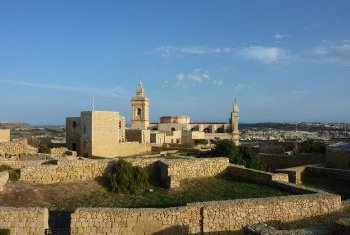
Victoria has a few things going for it: Firstly the view from the elevated citadel all over Gozo and beyond is spectacular. The is, when you enter the town walls, a nice compact square with stairs ascending to the Cathedral, with a cupola and impressive baroque tomb stones inside. Downtown, there is another basilica dedicated to St. George with a baldacchino which is an obvious smaller copy of the famous one in St. Peters in the Vatican by Bernini and a lovely, Byzantine chapel with mosaics. Like its sister-town of Mdina on Malta the high walls of the citadel are impressive site from far away and every direction.
But that is about it! The citadel has very little left beyond the walls and the citadel, large parts consist only of walls and grass. If you compare it to Mdina, which in my opinion has no OUV, it has considerably less to offer. It is lovely as a visual centre of Gozos gorgeous landscape but then you would have to include the entire island. The most outstanding feature are its churches but there are even more impressive churches on Gozo alone, for example the neo-renaissance Parish church in Qala, the neo-baroque Nadur Parish Church, the Xaghra parish church with 20th century frescoes, the huge rotunda of Xewkija, and above all the really stunning Basilica of the National Shrine of the Blessed Virgin of Ta' Pinu, imitating italian romanesque style in an english fashion, for me the most beautiful church on both islands. Most of these churches have large or even huge rotundas and seem way too large for their villages.
You find a similar accumulation of huge, ornate churches all over the island of Malta. And since the Knights of Malta ruled in the 17th and 18th centuries most of them are baroque and very opulent. Unfortunately, this is not my favorite style but they are so impressive that we visited nontheless about 30 of them during our 10 days in Malta, perhaps even more, and what is flabbergasting beyond their almost absurd number and size is how well they are maintained. When we looked closer at the mostly baroque artwork we realized that many frescoes were actually not old at all: some sinners had a drug syringe in their hand (Maltese people told us about great drug problems, mainly with immigrants) and some figures even had covid masks!! But there quality was high enough that didn't realize the youth right away! We learned also that many of the churches were only built in the 20th century imitating skillfully baroque or other styles. That means that the Maltese not only give still extrem priority to the splendor of their church but also that they invest huge sums for this and that the probably have a living tradition of sacred painting and frescoes of an astounding level, even more so, if you consider that the whole state has only about half a million inhabitants!
You can see this density of churches from literally every spot on the islands. There will not be many open places were you would not see at least a few cupolas and towers. I wonder why they never made a nomination of this since it is probably unique in the world. Perhaps because it would mean to inscribe the island completely? Well, on Menorca half the island is the buffer zone for the Talayotic constructions too! The obviously very strong living tradition of general faith and artistic skills is something that would please UNESCO I would think. Another option would naturally be to include only the most stunning and large churches but that would still mean a large number. If you look for stunning architecture in Malta that is not prehistoric there is nothing to compete with its over-the-top churches.
Comments
No comments yet.
